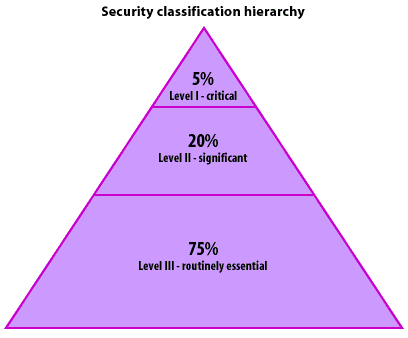| Lesson 6 | Security Policy System Classification |
| Objective | Develop a security policy by classifying systems according to risk and business criticality. |
Developing a Security Policy through System Classification
An effective security policy starts with a clear understanding of the organization’s systems and the risks associated with them. Classifying systems by importance allows administrators to allocate resources efficiently, prioritize protection, and develop layered defense strategies. Without such classification, even well-funded security programs risk misalignment between policy and actual threat exposure.
Understanding Security Classification
A security policy defines what it means for an organization or system to be “secure.” It specifies rules of behavior, control boundaries, and access constraints-both for users and for adversaries. These policies govern how data flows, which entities may interact, and how violations are detected or prevented. Declaring a system “secure” is meaningless without an explicit policy describing what that entails and how it is enforced.
Security Classification Hierarchy

- Level I - Mission-Critical Systems: These systems cannot tolerate more than a few hours of downtime. Examples include certificate servers, customer billing, registration systems, and e-commerce web servers. They are often Internet-facing and typically represent about 5% of total IT assets.
- Level II - Operational Systems: These are business-line applications and internal servers that can endure short outages (up to 48 hours). Roughly 20% of resources fall into this category and are usually internal, protected behind firewalls, and isolated from public access.
- Level III - End-User and Support Systems: Workstations, local applications, and systems that can be offline for a week or more in emergencies. These generally make up 75% of total resources and rely on backups and redundancy for resilience.
The Information Assurance Technical Framework (IATF)
The Information Assurance Technical Framework, developed by the NSA’s Information Assurance Technical Framework Forum (IATFF), outlines security processes grounded in systems engineering. It integrates three critical domains-people, operations, and technology-as the foundation of the Defense-in-Depth approach, ensuring layered protection across an enterprise.
Defense-in-Depth Principles
Defense-in-Depth is a layered security strategy designed to ensure that a breach at one layer is contained by the next. This model includes the following components:
- Defending the network and infrastructure
- Defending the enclave boundary
- Defending the computing environment
- Supporting infrastructures such as authentication and key management
An enclave refers to a collection of computing environments under a single authority and unified security policy-such as a LAN, data center, or mission network. Enclaves implement boundary defense, incident response, and standard information assurance capabilities. They may be categorized as public, private, or classified depending on the sensitivity of the hosted systems. The Defense-in-Depth methodology assumes each enclave inherits the highest mission assurance category of its contained systems.
Determining System Risk and Prioritization
Once systems are classified, assign risk factors to each based on sensitivity, exposure, and business impact. The higher the sensitivity, the greater the protection required. A Level I system demands immediate recovery and robust controls, while a Level III workstation may only need endpoint protection and backup rotation.
Security administrators must avoid overclassifying resources as Level I. For instance, email servers-while essential for communication-usually belong in Level II because downtime does not halt all business operations. However, public-facing e-commerce servers should be Level I because their unavailability directly affects revenue and reputation.
IoT Privacy Considerations
The rise of the Internet of Things (IoT) introduces new layers of privacy and correlation risk. The guiding principle is simple: risk exists when it is viable and probable that identity can be correlated to activity. Determining this viability requires evaluating whether a reasonable and informed person could access, combine, or infer the necessary data using available time, skills, and motivation.
IoT data becomes personal only when identity can be meaningfully linked to behavior. However, such correlation often requires multiple, inaccessible datasets-device logs, carrier records, and gateway logs-that are rarely consolidated. Overstating these correlations can lead to poor design or excessive compliance burdens. Security policies should therefore address both viability and probability when defining IoT-related risk controls.
Documenting and Implementing Your System Classification
Before finalizing a security policy, create detailed documentation for every classified system, including:
- Hardware and software configurations
- Network interfaces and communication protocols
- Assigned classification level (I–III)
- Associated risk factor and recovery objective
- Dependencies and backup mechanisms
Maintain a prioritized threat and action list for each classification level. This ensures that mitigation strategies align with business continuity goals and that resources are directed where they matter most.
Modern Cryptographic Standards
Replace outdated algorithms such as DES with modern standards like AES for encryption and SHA-256+ for hashing. These standards align with current best practices for both Level I and Level II systems and should be explicitly stated in your security documentation.
By classifying systems effectively and aligning security measures with business priorities, organizations create resilient infrastructures that adapt to change while maintaining protection across every operational layer.